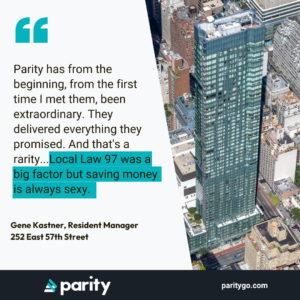
Our HVAC systems were “running wild,” said former board president Dan Donnelly. “In terms of energy, we were performing in the bottom 5% of New York City buildings.”
The building had a D energy grade and faced Local Law 97 (LL97) penalties estimated at $65,000 in 2030.
252 East 57th Street is a 65-story luxury high-rise in Manhattan that is part condo and part rental – each with different HVAC systems.
The rental units use heat pumps, but the condos use four gas-fired boilers for heating and compressors to operate chillers for cooling. Each of the 95 condo units are equipped with four-pipe fan coil units for heating and cooling at any time.
After discovering the poor energy grade and looming LL97 fines, the condo board set up an energy committee led by Dan Donnelly to figure out how to reduce the building’s carbon emissions.
Dan was well-informed about LL97 and building/HVAC efficiency. He was very keen on automation and understood he took the building as far as he could with the existing building staff and Building Management System (BMS) in place.
Gene Kastner, the former Resident Manager at 252 East 57th Street, referred Donnelly to Parity for a high-level and technical overview.

After scoping out the building, we discovered that the largest limitations and problems at 252 East 57th Street came from the HVAC system operations.
We came in with our Optimizer service to fill in the gap and included a large upgrade to their BMS.
Our projected guaranteed savings for 252 East 57th Street was at least $90,000 during the first year.
We over-delivered and saved the building $165,917 in utility costs!
This means that instead of our projected 1.7 year payback, they got their ROI in 8 months.
We also supported Dan’s concern with the LL97 fine. We reduced 252 East 57th Street’s exposure to fines by $60K. That also translates to 226 tons of avoided CO2 in our atmosphere.
We pride ourselves in our ability to decarbonize buildings across NYC by fine-tuning their HVAC systems to run more energy efficiently. And our work here was one of many examples of us doing exactly that.
Let’s take a look at how we were able to reach the $165,917 in savings.
Our savings were largely driven by maximizing evaporative over mechanical cooling. Evaporative cooling, known as free cooling, uses outdoor temperatures via the cooling tower to reject heat from the water in the system, which uses less energy than the compressors to operate a chiller.
“When the system was designed, it was relying a lot more on the chiller,” Kevin Lin, our Director of Systems Integration explains.
The resident manager was then tasked with manually switching to free cooling when outdoor conditions allowed, something that could easily be overlooked. With the new system, the transition to free cooling takes place automatically.
“Last December, we were able to reduce peak demand by 300 to 400 kW, which is significant,” Kevin reported.
Another area of savings came from modifying the building’s make-up air units, which replace air that is ventilated from apartments with exhaust fans.
The condo apartments also have high-end kitchen range hoods that remove a large volume of air. The make-up air units were working at the maximum, even though the range hoods were not in use all day.
“We were able to adjust the airflow so the load met the demand,” Kevin says.
Similarly, the domestic hot water preheating system wasn’t set up to be energy efficient. Water was being preheated 24/7, even during the day when demand was low. We updated this with a combination of variable frequency drives (VFDs) that heated water automatically based on demand and our software.
“A lot of times the pump was just moving water when there was no water on the other side that needed to be preheated,” Kevin says.

After installation and commissioning are complete, we monitor the building’s HVAC systems to ensure energy efficiency is met and alert the building staff if any issues arise. We do this with Pi (Parity Insights).
Pi keeps Resident Managers like Gene informed about critical HVAC metrics, helps detect and solve anomalies, and provides timely alerts. Our dashboard offers a window directly into how we are optimizing your HVAC systems.
We have a robust alerting system that we fine-tuned to Gene’s exact specifications to warn him of HVAC issues at 252 East 57th Street before resident comfort is affected.
When you partner our control optimization software with our Pi dashboard, you get an advanced energy efficiency solution primed to lower your utility costs, guaranteed.
Are you ready to bring Parity into your building? Email contact@paritygo.com or call 1-833-372-7489 to see if your building is a good fit. You can also visit our website to learn more about how we reduce utility bills in multifamily residential buildings and hotels.